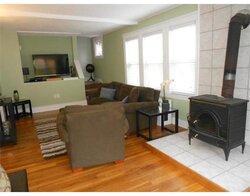Hi all, new here and to wood stoves. Hoping I can get some help. Haven't been able to figure it out.
I just bought a house and right before closing the seller told us that they didn't actually have a permit for the wood stove. She said that she had the fire inspector come in and he said it needs around another foot of clearance in the front.
Reading the MA laws it seems like you need 36" of clearance all around, but as long as the stove was installed to the guidelines in the manual it should be all set for reduced clearance. Can anyone help clarify this for me. Am I understanding wrong? I would like to know before sure before I call the inspector up and make a fool of myself.
It's a Dutchwest convection heater 2461
Here's a picture of the set-up.

Also I need to get a new refractory package. The one that is there is wicked damaged. Anyone know where I can get one quick, and not spend an arm and leg?
Thanks in advance!
I just bought a house and right before closing the seller told us that they didn't actually have a permit for the wood stove. She said that she had the fire inspector come in and he said it needs around another foot of clearance in the front.
Reading the MA laws it seems like you need 36" of clearance all around, but as long as the stove was installed to the guidelines in the manual it should be all set for reduced clearance. Can anyone help clarify this for me. Am I understanding wrong? I would like to know before sure before I call the inspector up and make a fool of myself.
It's a Dutchwest convection heater 2461
Here's a picture of the set-up.

Also I need to get a new refractory package. The one that is there is wicked damaged. Anyone know where I can get one quick, and not spend an arm and leg?
Thanks in advance!



